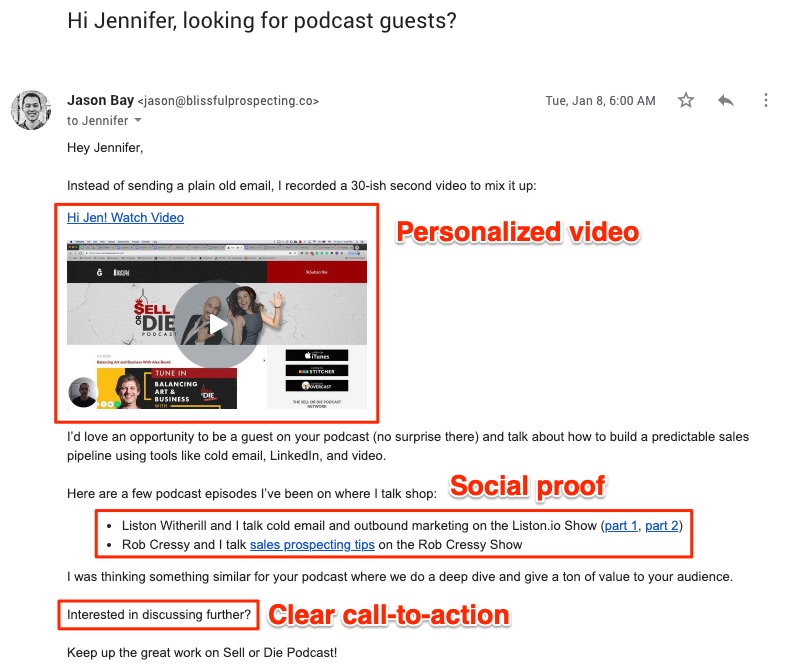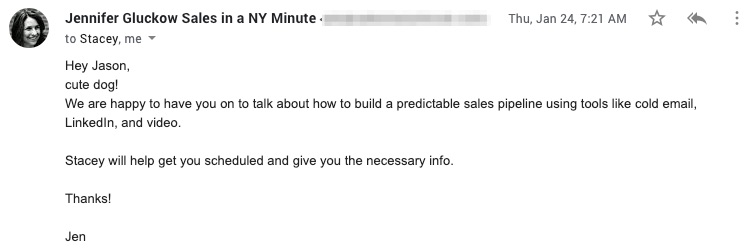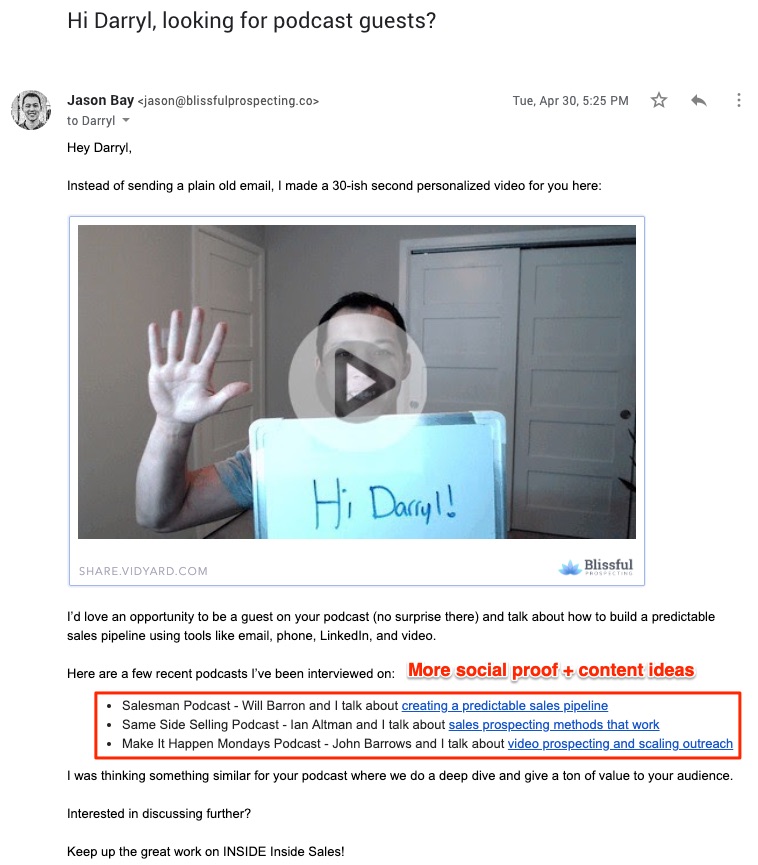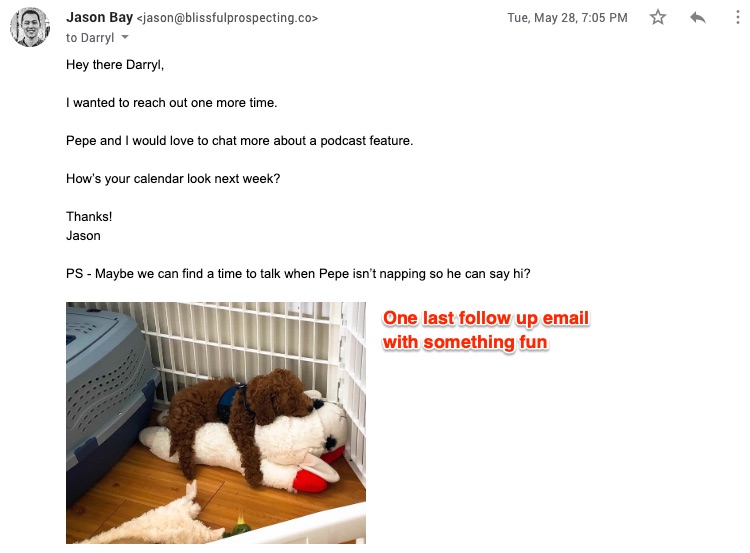We’ve used these to get 35-65%+ open rates.
✅ Technique #1: Rule of 3
Mention three seemingly random things from your cold email
▶ Sustainability, Tom’s, 2020
▶︎ Template: [personalization], [company name], [year]
✅ Technique #2: Be mysterious
Create curiosity
▶︎ Hey Jason, I was researching Blissful Prospecting and…
▶︎ Template: Hey [first name], I was researching [company name] and...
▶︎ Hi Jason, your audit?
▶︎ Template: Hey [first name], your [area you help]?
✅ Technique #3: Be Familiar
Leverage referrals or potential users
▶︎ Hi Jason, was just talking to Sara
▶︎ Template: Hi [first name], was just talking to [referral]
▶︎ Sara Bay said to reach out
▶︎ Template: [referral] said to reach out
▶︎ Sara Bay and Travis Johnson
▶︎ Template: [user] and [user]
✅ Technique #4: Problem-Centric
Describe a common problem
▶︎ Utility overages
▶︎ Low conversions
▶︎ Template: [problem]
✅ Technique #5: Voicemail First
Call first, leave a voicemail, then email
▶︎ Hey Jason, just left a voicemail
▶︎ Template: Hey [first name], just left a voicemail
Want more ideas?
Check out Alexine Mudawar and Jeremy Leveille today on the Think Outside the Script virtual tour.
Free all-access pass here.
Join the conversation on LinkedIn here.
Jason
One of the big challenges of any business is building social proof. Maybe you're in a position where very few people in your industry know of you. You're hopping on sales calls and prospects have never heard of you. Or you have few or no case studies.
This was the case when we started Blissful Prospecting back in 2017. Since leaving my full-time job in 2013, I consulted with a few dozen companies on their marketing and sales. But I only had one relevant case study for how I helped a client with outbound. And three clients I was doing outbound for.
This made sales tough. We didn't have a lot of social proof.
I dealt with these objections all the time:
Prospects didn’t see me as an expert. How well we did for the few clients we had didn’t matter. We only had a few of them. Prospects were skeptical, which is understandable. They'd never heard of me and didn't see anyone else in our industry talking about us.
But then a few people asked me to be on their podcasts (thanks Liston and Raj). And then introduced me to other podcasters.
Over time, people started taking us more serious in sales calls. And they started treating me like an expert. Asking what I thought THEY should do, instead of asking about my experience.
Then a light bulb went off. If a few podcasts had this much impact, what would happen if doubled down on this strategy? What would that do for our business?
Sara and I realized that social proof should be the foundation of our client acquisition strategy.
I’m going to share behind the scenes of the process we used to land 27 (and counting) interviews on top sales podcasts like…
And I'll share what we learned along the way.
Here's what I'll cover:
I hosted a podcast from 2014 to 2016 called the GenY Success Show. It talked to Millennial/GenY entrepreneurs that left their jobs to start businesses.
So I was already sold on podcasting as a medium. Every time someone interviewed me on another podcast, our audience grew along with our email list.
We also knew that social proof was essential for building our brand. Getting interviewed on a big show put our brand next to an already reputable brand.
Robert Cialdini explains it best in Influence:
Social proof is one type of conformity. When a person is in a situation where they are unsure of the correct way to behave, they will often look to others for clues concerning the correct behavior. When "we conform because we believe that others' interpretation of an ambiguous situation is more accurate than ours and will help us choose an appropriate course of action", it is informational social influence. [1]
If your peers endorse a business, you’re more receptive to endorsing it.
Almost every A-lister in our industry has a podcast. Or has been interviewed on dozens of them.
We positioned Blissful Prospecting as a credible player in the space through interviews on all the top sales podcasts.
A few friends have podcasts, which was a great place to start. Plus, I could mention our interview in my cold emails. Social proof in action again.
My friend, Raj, has a podcast called Startup Hypeman, which helps SaaS founders and salespeople with their sales and marketing.
He also introduced me to Rob, who runs a marketing podcast for agencies in the sports industry.
Then I met Liston Witherill, who hosts a sales podcast, through a mutual connection. That shared connection also introduced me to Michael Knouse over at the Startup Sessions podcast.
You can see and listen to these podcasts here. They're listed in chronological order.
Then Sara landed a few podcasts through women she met in a Slack group. Before I started cold emailing podcast hosts, we had 11 podcasts under our belt.
Before reaching out to top podcasts in your industry, create content that showcases your skills first. Podcast hosts love seeing examples before committing to an interview. Their biggest pet peeve is wasting time with a bad guest.
Here are a few strategies for finding podcast opportunities early on:
Not all podcasts are created equal. I learned that from my time running the GenY Success Show.
I always gave away something after the podcast with a special landing page. Usually a PDF or guide to help people on the topic we talked about.
Some podcasts had a huge response. Dozens of people emailed me afterward, connected with me on LinkedIn, and signed up for my email list.
But other podcasts (even ones from well-known, popular hosts) didn't have the same response.
Coming into this campaign, I didn't want to spend any time on a podcast with little engagement. I could always come back to them when they grew their audience.
Per episode downloads are the number one qualifying criteria for any podcast. But that's hard to find unless they publicly show the numbers. Or talk about it in their podcast (also not super reliable—most people exaggerate).
Here are the criteria I used:
The key is finding relevant podcasts in your niche. If you're too general, your message won't stick with listeners.
Start with iTunes. Here's what I did:
Then head to Google:
Then head to social. Depending on your industry, LinkedIn is usually best for B2B:
Add the good-fit podcasts to a spreadsheet. I prefer Google Sheets so you can collaborate. Or so you can have a virtual assistant do this portion.
Here's how we found contact information for 95%+ of the podcast hosts:
Build a target list of all the podcasts you want to reach out to first.
Not all podcasts are equal. It's okay to find smaller podcasts when getting started. You need social proof to impress bigger shows.
There will be 50-100+ podcasts that would be great for you. Score the podcasts to prioritize your time accordingly and reach out to the smaller shows first.
Before you get too excited, this approach IS NOT about the email template.
Sending cold outreach isn't about the template.
This worked for me, but copying and pasting the email copy below won't work for you.
Emulate the structure and framework of my emails.
This is what the four email sequence looks like:
Overall stats:

As you can see, a pretty impressive open rate of 79% and a reply rate of 42%!
Each email is broken down here along with the individual stats at each stage.

When I started sending these emails, we didn't have much social proof. I shared everything that was relevant.
Here's the email that landed us the interview on Jeffrey Gitomer and Jennifer Gluckow's podcast, Sell or Die!

And here was her response:

Here are the critical parts of this email:
This was one of the earlier opportunities I landed. Here's how the email changed over time:


Podcasters have two big challenges: finding great guests and coming up with topics.
My goal is to make it easy for people to say "yes" to me. And to remove as much thinking as possible.
The first email focused on building social proof and introducing myself as a credible guest who can add value to their audience.
The second email focused on making it easy to see what we could talk about in an interview:

These are topics I'm not only well-versed in, but that I know salespeople want to hear about. I lead with empathy and acknowledge that they probably get these kinds of emails a lot.
I provided a list of specific topics, along with a link back to content demonstrating my knowledge on the topic. Social proof at play again.
Here are those links if you want to check them out:

The goal of this email is to showcase persistence, but not in an annoying way. And to show a personal/funny side of me as well.

That's right, I'm pulling the "I have a cute puppy card."

This is the last email in the sequence. Nothing too special here. There's a call back to our puppy, Pepe, and one more call to action to chat about the podcast feature.

It's not required but will significantly increase your reply rates. Videos are not easily faked, especially if you're very specific with the personalization.
If you listen to any of the podcasts we landed, you'll hear the hosts talk about how much they appreciated the video.

Check out our video prospecting guide to learn how to use video in your cold outreach.
If you don't take the time to personalize your emails, DO NOT BOTHER reaching out to big podcasts. It won't work. And you’ll look like a fool.
Think about the message before you send it. Would you respond?
And make sure to follow up. I use MixMax and Vidyard to send out emails and videos.
Your outreach should do the following:
In my experience, most podcast hosts prepare very little before the interview. If you book an hour-long slot for the interview, they usually spend the first 5-15 minutes talking about what the episode will cover.
Take it upon yourself to prepare. It's in your best interest. If the host really likes the interview, they’re more compelled to recommend it to their audience. Or introduce you to other people in their network.
Here's the process I use to prep for podcasts:

Podcast landing page example.
There's usually a 5-15 minute warm-up period right when you hop on a podcast. These questions help me tailor the interview:
Overall, we reached out to 92 podcast hosts, but 16 of those emails bounced because of bad email addresses. That left 76 people who received a cold email from me.
We converted those 76 podcast hosts into 27 interviews. 3 interviews are also recorded but have not aired yet. Also, some sequences are still going. I expect to land another 3-5 interviews.
Pretty successful campaign in our book!
We came across a few surprises. First, this approach was much more successful than we thought it would be. It also helped me overcome a bit of imposter syndrome.
All I could think about was why people might see this is as a desperate attempt to get on their podcast. Many of the podcast hosts are people we are and want to be peers with.
In reality, only one response mentioned that they didn't accept solicitations for their podcast. And they were nice about it. All that worry for nothing.
Our conversion rate into interviews booked was 35.5%, which is great for any cold email campaign. But that also means that 2/3 of podcast hosts either rejected me or didn't respond.
Here are our biggest takeaways:
We get this question from a lot of sales teams.
A big challenge with cold email is the number of variables you're dealing with.
It's hard to pinpoint what's wrong if you're not getting responses.
Here's a checklist (using the REPLY Method linked here) you can use to fix cold emails that aren't working:
1️⃣ Low open rate (should be 30-50%+)
- A/B test the subject line
- Make sure the first line of the email is personalized and relevant (this shows up in the preview on their email client)
2️⃣ Low reply rate (should be 5-10%+)
- Share relevant results you've created for others (leverage social proof and case studies)
- Use an empathy-based approach by leading with the prospect's challenges
- Keep your outreach laser-focused (one CTA, 3-5 sentences or less than 120 words)
3️⃣ Low conversion rate into meetings (should be 3-6%+)
- Again, make the CTA clear...try being more specific with the day and time for a call
- Call the prospect...if a prospect responds "not interested" pick up the phone and call them. You'll get a ton of great feedback to improve your messaging.
We use the REPLY Method for writing and troubleshooting cold email messaging. Check it out for a more in-depth guide.
Join the conversation on LinkedIn here.
Jason
PS – Here are three ways to help grow your outbound sales:
It's usually because of a very specific reason.
Most prospecting advice is very tactic-based. Don't get me wrong, tactics are essential.
But sometimes we need to get back to the "why" of prospecting.
Back to the basics.
Why would a prospect want to hop on a call with a salesperson they don’t know to begin with?
Here's a straightforward way of looking at it:
The goal of prospecting is to pique interest and show enough value that the prospect feels it's worth 15-30 minutes of their time to hop on a call to talk about how you can solve a problem for them.
Prospects have problems. We have solutions. That's it.
If you’re not leading with the problems that you solve, you more than likely won't get a response. That's step #1.
But you can't talk generically about those problems.
You have to show empathy and speak in their language.
It has to be personal. And it's even better if you can talk about specific situations when their challenges intersect with areas in which your product/service can help them.
I call those "sticky situations."
I was just on the Daily Sales Tips podcast with Scott Ingram and talked about how to find sticky situations. Check it here.
Join the conversation on LinkedIn here.
Jason
PS – Whenever you’re ready, here are three ways we help sales teams grow their outbound sales:
Connect on LinkedIn. I post daily about prospecting, sales, and how to be an outbound badass.
Reply Method Guide. Our messaging framework for increasing response rates, setting more meetings, and closing more deals.
Work with us. Get help increasing your team’s outbound sales by 2-3x. Schedule an outbound strategy session to learn three key strategies for crushing your revenue targets this year and see if Outbound Accelerator is right for your team.